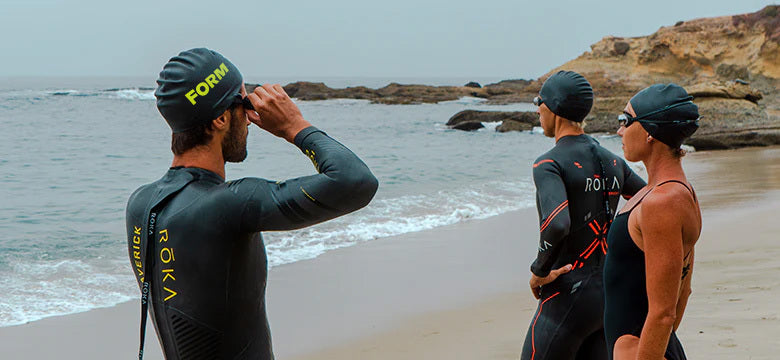Seven Triathlon Swim Strategies
You’ve practiced for months. Your stroke is feeling strong. You’re confident in open water. You’ve ticked all the boxes, and now it’s time for you to hit the waves and crush this triathlon swim. Something is thrilling about the start of a triathlon swim, but you can sometimes feel a bit anxious. The thought of sharing the water with a hundred other swimmers can leave many triathletes intimidated, which can result in coming out of the water disappointed, whether it's their first, second, or hundredth triathlon.
No matter what level you’re at, you need a triathlon race-day strategy to thrive during your swim. You want to get on your bike feeling strong, not like you need to make up time.
Here are seven triathlon swimming strategies and techniques to excel in the water during your next race.
1. Schedule a warm-up before the race.
Whether it’s your first or fortieth race, there will always be some level of nerves before you get to that start line. That’s why it’s essential to take some time before the gun goes off to warm up your muscles and slow down your heart rate.
Some triathletes will warm up with the 10/10/10 method: 10 minutes of easy running, 10 minutes of biking, and 10 minutes of swimming. Swimming should be last, so you don’t have to change again before you line up. If 10/10/10 is too long, your bike and run could be shorter, but it’s vital to swim at least 10 minutes, so your muscles are ready for what’s directly ahead.

Once you get to the start line, it’s time to calm your nerves. You don’t want to start with a racing pulse and short breaths. Focus on slowing down and taking a few deep breaths.
2. Start swimming at your own pace.
The first buoy in an open water race is usually about 100 to 400 meters from the start. For the triathletes gunning for the win or an age group podium finish, it tends to be an all-out sprint to get there, but that doesn’t mean you have to be right in the middle of the sprint. You'll want to adjust your strategy to get to this buoy, depending on your strength as a swimmer.
If you’re a confident swimmer or experienced triathlete, you can stay with the pack and attack that first buoy with everything you’ve got. You can prepare for this by swimming with a few other strong swimmers beforehand. Choose a point out in the lake or ocean that’s around 100 meters from shore. Swim tightly together while all swimming at your sprint pace. Repeat this a few times throughout your training block to get used to swimming hard while also jockeying for position with a few other swimmers.
Whether this is your first triathlon, you’re not a confident swimmer, or you’d just prefer not to get swum over by a hundred other triathletes, you’ll want to stay clear of the leading pack. Go to the side, let the others get to the buoy, and stay close behind them. This approach doesn’t mean that you’re not swimming hard; it just means you’re avoiding the craziness of the main pack by not swimming in a straight line to that first buoy. You’ll only lose 15 or 20 seconds in the long run, which allows you to start your swim much calmer and controlled.
3. Find a group and stick with them.
After that first buoy, the pack will start to spread out, and the swimmers will settle into their triathlon swim pace. If you don’t think that they couldn’t hold on to that pace for the entire race, you’re right; they probably can’t.
Next, the goal is to find a group that is swimming slightly faster than you so you can draft behind them. By drafting, you’ll get the benefits of their speed and a pace to hold on to, plus you’ll be able to conserve your energy. If you’re with an experienced group, you may not need to sight as often as you would if you were alone.

The downside of drafting is the possibility of getting stuck behind a slower group. If this happens, you’ll have to work extra hard to get around them and make your own pace. You’ll also want to remember to sight for yourself from time to time, just in case your pack is heading off-course.
4. Know your pace before you race.
Unlike running and biking, it can be tough to look down at your watch to check in on your pace during your swim. It’s not impossible, but it can take you out of the rhythm of your stroke. Because of this, it’s so important to get a good feel for your target race pace before your triathlon.
Your pace should be quick yet not too fast that you can’t give it your all for the next two legs. You don’t want to be crawling up the beach to hop on your bike.
With the rush of adrenaline at the beginning of a race, triathletes often start too fast. Resist this urge. Try to slowly build your speed and aim for a negative split—meaning your second half is faster than your first. You’ll feel great being able to finish strong, and you’ll be ready for your bike and run.

Pacing is one area where FORM goggles can give you a competitive advantage. With real-time pace data or heart rate data displayed inside your goggles, you'll be able to adjust your effort to match the target effort you established before the race.
5. Don’t sight too much. Don’t sight too little.
Sighting is the technique of looking up from your stroke to make sure you’re going in the right direction. It’s a crucial skill for open water swimming, especially during a race. Learn how to sight here.
Whenever swimmers sight, they need to lift their head and change their stroke to see ahead. Since this is potentially more taxing than your typical technique, try and sight just enough to keep yourself on track. Do this every four strokes if you’re newer, six strokes if you’re intermediate, or eight strokes if you’re more advanced.
If you know that you’re drafting behind someone experienced, you may be able to sight even less. But, even then, you should be sighting every so often to make sure that you’re on course.
6. Train in your wetsuit.
Another common issue that you may face in races is how a wetsuit can affect your stroke. Don’t make the mistake of wearing your wetsuit for the first time on race day. Wetsuits tend to increase your buoyancy and decrease the range of motion in your shoulders, so wetsuit swimming is something you should be practicing. Remember - never do something in a race you haven’t done in training!

7. Lubricate your wetsuit.
This is one way to shave seconds off your time that requires practically zero practice. When you put on your wetsuit before the race, simply rub some wetsuit lubricant on your wrists, forearms, ankles, and calves. You can also put lubricant on the outside of the wetsuit in the same areas. Then, when you’re heading onto your bike, your wetsuit will come off a lot easier than if you had to peel it off your skin. While it doesn’t involve that much prep, you should still practice it before your race. On race day, you’ll slip out of your wetsuit seconds faster than anyone else around you.
It’s crucial to maintain calm and confidence during your triathlon, especially during the first leg. By using these swim strategies, you’ll be able to confidently head into your first transition with enough energy to thrive on your bike.
Use FORM to Your Advantage
Swimming is technically complex and takes time to master, but that’s where we come in! Improve your pace and become a better swimmer with a FORM membership.
As a member, you’ll have access to:
-
Real-time metrics & In-app Swim Data
- Use real-time metrics in your goggles to know your pace after each interval (50 or 100m/yd), as well as your distance per stroke to maintain consistent pacing. Post workout, check your in app swim data for the full rundown on.
-
FORM Plans and Workouts
- Follow a training plan designed by our expert swim coaches. With 20+ options to choose from, swimmers at all levels will improve and efficiently work towards their goals.
- Plans for triathlons:
- Sprint Triathlon
- Olympic Triathlon
- Half and Full Iron
-
Custom Workout Builder
- Create your own workout, input one from a coach, or edit one of ours to meet your own pacing goals.
Join now to improve your pace with a FORM membership—includes worry-free, 30-day return guarantee.
Already have FORM goggles, but don’t have access to our full range of features? Head to the FORM app to start a 30-day free membership trial*.
*30-day free membership trial is only valid for one-time use for new members who have previously purchased FORM goggles.










